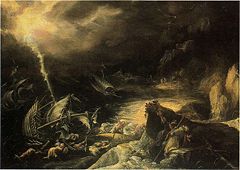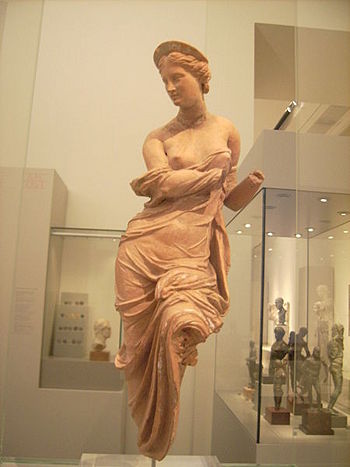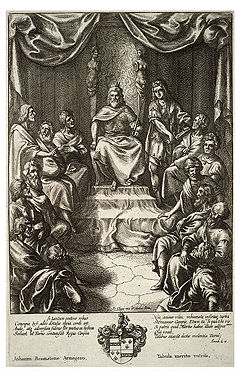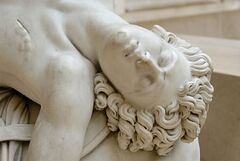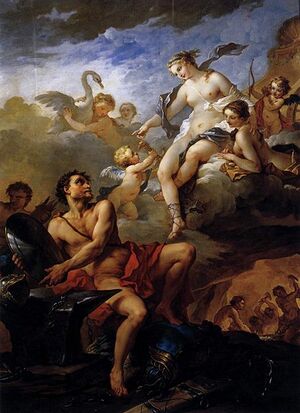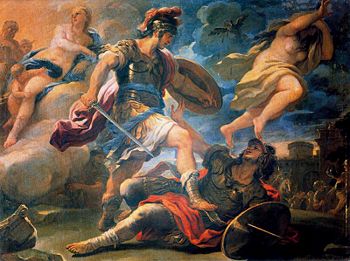Archive:New Draft of the Week
The New Draft of the Week is a chance to highlight a recently created Citizendium article that has just started down the road of becoming a Citizendium masterpiece.
It is chosen each week by vote in a manner similar to that of its sister project, the Article of the Week.
Add New Nominees Here
To add a new nominee or vote for an existing nominee, click edit for this section and follow the instructions Ellesmere Chaucer manuscript Ellipse
| Nominated article | Vote Score |
Supporters | Specialist supporters | Date created |
|---|---|---|---|---|
| Ellipse | 2 | Daniel Mietchen 13:12, 1 May 2010 (UTC); Chunbum Park 00:37, 8 May 2010 (UTC) | April 28, 2010 | |
| Ellesmere Chaucer manuscript | 1 | Daniel Mietchen 13:12, 1 May 2010 (UTC) | April 22, 2010 |
If you want to see how these nominees will look on the CZ home page (if selected as a winner), scroll down a little bit.
Transclusion of the above nominees (to be done by an Administrator)
- Transclude each of the nominees in the above "Table of Nominee" as per the instructions at Template:Featured Article Candidate.
- Then add the transcluded article to the list in the next section below, using the {{Featured Article Candidate}} template.
View Current Transcluded Nominees (after they have been transcluded by an Administrator)
The next New Draft of the Week will be the article with the most votes at 1 AM UTC on Thursday, 27 May, 2010.
| Nominated article | Supporters | Specialist supporters | Dates | Score | ||||
|---|---|---|---|---|---|---|---|---|
The Aeneid is the great national epic Latin poem of ancient Rome. It is an important literary work in Western civilization which has influenced countless other important books such as Dante's Divine Comedy or Commedia. It's the story of Trojan hero Aeneas, therefore the name Aeneid. It was originally written in Latin in dactylic hexameter and has been translated widely. The story did for ancient Rome what the Iliad and the Odyssey did for ancient Greece. It built on the famous topic of the Trojan War and its aftermath but took the story in a new direction by weaving an after-the-fact account of the creation of Rome while expressing the essence of Roman culture to Romans themselves. While it was a deliberately fabricated historical myth built in a structure often parallel to the Iliad and Odyssey, it focused on different themes such as leadership, the relation of the individual to the state, the struggle between desire and duty, the power of fate, and the changing power and influence of gods, particularly the Roman gods Juno, Venus, and Jupiter. It quickly became a textbook for Roman students to learn about their culture and their language. Furthermore, it reflected a new synthesis of Greek and Latin culture. Origins of the Aeneid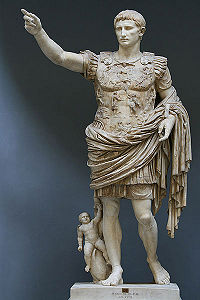 PD Photo of a sculpture Augustus Caesar, the effective dictator of the Roman Empire who called himself the Princeps, commissioned Virgil to create the Aeneid, indirectly through Maecenas. Virgil (70-19 BCE) was a well-educated Roman poet who lived around the time of Augustus Caesar but he had never written an epic. At the time, the Roman Republic had dissolved into essentially a military dictatorship led by the so-called Princeps or "First Citizen", as the Emperor preferred to call himself, so that many of the appearances of the Republic remained such as the Senate, but government was increasingly dictatorial. The work was commissioned indirectly by Emperor Augustus Caesar via an intermediary named Maecenas. Ancient sources suggest Virgil began with a prose draft first, and turned it into a poem, although there are disputes about this by some scholars.  (PD) Drawing: Thomas Wright Sulcer The dactyl is composed of one long syllable followed by two short syllables; it is a prominent part in the type of poetic verse called dactylic hexameter which the Aeneid was written in. Virgil built upon the Iliad by expanding a minor comment about a minor character known as Aeneas. Virgil assumed that his readers knew the basic outline of the Iliad and Odyssey. In the Iliad, Aeneas was a minor character mentioned briefly in book 20 in which the sea-god Poseidon prophesied that Aeneas would survive the burning of Troy (ancient city) and become the founder of a new city. But the Iliad did not specify which city this would be. Virgil used this ambiguity to determine that the city to be founded by Aeneas would be, in fact, Rome. There is no substantial written historical evidence to assert that Aeneas was, indeed, Rome's founder, although there were some accounts by Greek writers in the fifth century BCE that Aeneas' new city was Rome. According to stories about the Trojan War, some of which have not survived (but they're alluded to), Aeneas was the son of a human named Anchises (who was a Trojan) and the goddess Aphrodite or called by her Roman name of Venus. He survived Troy's fall and fled to Italy where he married the princess Lavinia and founded the city Lavinium; and Aeneas' son Ascanius founded the neighboring Italian city of Alba Longa. This happened in the period from 1184 BC to 753 BC, and allows Virgil to establish Aeneas as a "founder" of Rome, even though there's another myth of the founding of Rome which describes the battling between two brothers, Romulus and Remus. According to legend, Romulus killed Remus around 753 BC, invited others to join him in his new city, and abducted Sabine women as their wives to enable the population growth of the city of Rome. In essence, Virgil doesn't contradict the Romulus and Remus origin story, but finds a way to have both stories co-exist along a timeline of history, and repeats the pattern of the city's founding because of (1) battle between two men (2) intermarriage between men and women from different places. Virgil wrote the Aeneid in dactylic hexameter using rhymes positioned strategically to juxtapose key concepts. But while trying to perfect the last phases of his manuscript, he died on a sea voyage. While dying, he requested that his unpublished manuscript be burned, but Augustus ordered it preserved. Luckily the manuscript survived. It became popular rapidly in the Roman Empire. But there are indications in the text of inconsistencies and unresolved issues which might have been addressed if Virgil had completed his epic, and places where the hexameters were incomplete. The storyline
For a chronological look at the travels of Aeneas and the Trojans throughout the Mediterranean Sea, see the diagram. But the actual poem begins with Aeneas shipwrecked near Carthage, where he was soon to meet Queen Dido. During his visit in Carthage, Aeneas relates his story up until his visit to Carthage. 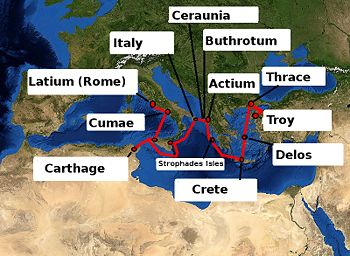 (licence) Imagetype: author PD Chart Aeneas fled Troy (ancient city) (right) and visited many locations, detouring in Carthage, and finally going to Latium which later became Rome. Fleeing TroyThe poem opens in the middle of the storyline, since Aeneas is Aeneas is a Trojan prince, cousin of Hector, and his mother was the goddess Venus and his father was a human. Key themes are present in the opening book that are elaborated throughout the story, and include the role of fate, the commitment to duty or the Latin word pietas. It is Aeneas' duty to found Rome; he's bound by fate. But Aeneas has an enemy in the Roman goddess Juno who is angry at the Trojans for numerous reasons: (1) prince Paris chose Aphrodite over Juno in a beauty contest (2) Troy was founded by an illegitimate son of her husband Jupiter (3) Jupiter abducted the Trojan prince Ganymede to be a cupbearer (so Juno hates the Trojan royal family) (4) Juno knows in advance that a Trojan will one day found Rome, and Rome is destined to wreak havoc on her favorite city of Carthage. But Aeneas has supporters too: his mother Venus is a powerful friend and helper who enlists the help of the god Jupiter and helps Aeneas by causing the Carthaginian queen Dido to fall in love with Aeneas; she's an information source too. And it's Jupiter's decree that Aeneas is destined to become the founder of Rome. Aeneas relates the story of the fall of Troy, with a detailed account of the clever strategem of the famous wooden horse as well as the machinations and deceit by the wily Ulysses used to convince the Trojans to take the horse into the city. While the Greeks burn the city, Aeneas escapes, but he's allowed to get a glimpse of the Greek gods literally knocking down the walls of the city. There are scenes of horrifying destruction and brutality. At one point Aeneas considers killing Helen of Troy but his mother, Venus, dissuades him. His father wants to stay behind, and Aeneas is about to stay behind with him; but a flame crowns young Iülus which persuades Aeneas's father Anchises to leave Troy, since it's an omen that his descendants will have future kingship. Aeneas departs with his family, including his father Anchises, his wife Creusa mysteriously walking behind, and his young son Iülus, as well as the household gods known as the Penates (a Roman construction; according to Greek mythology, there were no such household gods known as the Penates.) But Creusa is lost in the pandemonium, and when Aeneas returns to look for his wife, he sees her ghost who informs him that he will marry a royal bride in his future homeland. Aeneas and his family have a seagoing expedition which happens to follow in the pathway of Ulysees from the Odyssey, often stopping at the same points, but lagging behind only by a few months. They search for a new land but it's unclear where this will be. His wanderings parallel the adventures of the Greek hero from Homer. The Trojans land at the sacred island of Apollo named Delos and receive a prophecy from the god instructing them to seek the land of their ancestors. Anchises thinks this means the island of Crete, so they sail there only to encounter a plague ravaging the city. They land briefly on the island of the Harpies but are driven off, but they hear a prophecy suggesting that their final destination should be Italy but that hunger will cause them, in the future, to eat their tables. In Epirus, they find Helenus and Andromache who have built what is described as a new Troy and hear a prophecy saying that when they see a white sow with thirty piglets, then that's the place where they should build their new city. Aeneas hears that he must try to appease the goddess Juno and visit the Cumaean Sibyl. In Sicily, the land of the Cyclops, they find a Greek warrior abandoned by Ulysses a few months earlier; they feel sorry for the warrior and adopt him as part of their group. The kindness of the Trojans to the abandoned warrior illustrates the contrast between the Greeks and the Trojans; while the Greeks were so callous to leave behind one of their men, the Trojans (and future Romans), in contrast, are welcoming, forgiving, and good. Anchises, unfortunately, dies in Sicily. A Carthaginian QueenAeneas, like Ulysses narrating his back-story to the Phaiakian court, narrates his back-story to the Carthaginian court. There is an intense but troubling affair between Aeneas and the Dido. Venus, with complicity from Juno, caused Dido to fall deeply and passionately in love with Aeneas by sending a visit by Cupid in Book I of the story, so Dido had no choice in the matter and who is given the label infelix meaning unhappy, unlucky, cursed by fate. During a storm, Aeneas and Dido retreat to a cave and the liaison begins. She thinks of the relationship as a marriage and calls it that, but they were never married and there is no formal acknowledgment of their union. Perhaps Dido deludes herself into thinking of it as a marriage to possibly hide her guilt, because earlier, after her first husband had died, she swore an oath never to remarry. But the city of Carthage is rife with rumors of a romantic encounter between the two. A suitor rejected by Dido earlier, named Iarbas, tattletales about the affair to Jupiter who sends Mercury to give a message to Aeneas to call off the affair, and return to his duty to continue on his voyage and found the city of Rome. It is hypocritical of Jupiter to hold Aeneas to a double standard, since Jupiter had had many amorous out-of-wedlock encounters, and even raped many women, including goddesses as well as human women. It illustrates the gulf between the divine and the human, since gods and goddesses can get away with illicit behavior while humans must bear the consequences. Mercury reminds Aeneas of his duty; Aeneas understands. It illustrates a Roman virtue of duty to one's task.  (PD) Photo of a painting: Joseph Mallord William Turner Dido was building Carthage in this painting by Turner in 1815. Carthage and Rome were destined to be serious rivals for control of the Mediterranean Sea. Unfortunately Dido learns about Aeneas's planned departure before he had a chance to tell her. She is furious. In a tense scene, she confronts him, but Aeneas replies that he has no choice but to leave. His path has been fated, he tells her. Later, she kills herself out of intense passion, but before doing so, makes a curse against Aeneas and all his future Roman descendants. It's explained that this "curse" causes the Punic Wars between Carthage and Rome. When Virgil wrote the Aeneid, of course, these wars had been fought two hundred years earlier, so in a sense, Virgil had the benefit of hindsight in developing the storyline of the epic poem. There are numerous scholarly issues about how to judge the characters in this scene. Was Aeneas guilty of leading on Dido? Was Dido guilty of seducing Aeneas? While debate is unlikely to ever be settled, there are arguments to be made for both sides:
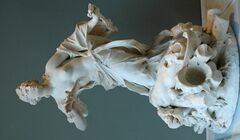 (PD) Photo of a sculpture: Augustin Cayot Queen Dido, deeply saddened by the abrupt departure of Aeneas, committed suicide; Aeneas saw her later in the underworld, but Dido refused to even look at him as she passed by.
SicilyAeneas sails to Sicily and participates in the funeral games marking the one year anniversary of the death of Aeneas' father Anchises. He is welcomed by King Acestes. The games are like the funeral games for Patroklos in the Iliad. Symbolically, the book marks a transition from a focus on the past (Troy) to the future (Rome). They're burying the past and preparing for a warrior future by exercising in the so-called lusus Troiae or "Trojan games". Incidentally, in then-contemporary Roman society, there were so-called "Trojan games" but there is little likelihood that they were based on games from the classical past; but this didn't matter to Virgil, who used the name "Trojan games" to reconstruct the past as if the games were named after supposed Trojan ancestors. It was an accepted practice to have athletic contests as a funeral celebration. But Juno incites the Trojan women to burn the ships as a way of ending the dangers of future travel. Juno appears in the guise of an old woman named Beroe who persuades the Trojan women to set the ships on fire to keep the group permanently settled in Sicily. Aeneas' son tries to stop them from doing so, but fails; instead, Jupiter saves the ships with an intense rainstorm. Aeneas is rattled by this event, and in a dream, he sees a prophet named Nautes advising him to seek out the Cumaean Sibyl and visit Hades to see his deceased father Anchises. Aeneas allows the women to stay behind if they choose; only one woman joins them on their continued expedition, and some of the men choose to stay behind as well. So now the expeditionary force is mostly men. While en route, the god of Sleep forces one of the vessel's pilots named Palinurus to fall asleep and plunge into the water to drown. The death results from a promise made by Jupiter to Venus that only one more Trojan will die at this stage, and Aeneas will see Palinurus in the underworld soon thereafter. The Underworld (PD) Photo of a drawing.: Wenzel Hollar Aeneas visited the underworld to get advice from his dead father. This painting by Wenzel Hollar was made before 1677 and depicts Aeneas (center). Virgil tells this part of the epic using the third person, and Aeneas' trip there is described by the narrator of the epic. Aeneas buries Misenus first before entering the cave to visit the underworld. Unlike the Odyssey in which Ulysses sees ghosts visit him from the underworld, Aeneas physically travels there accompanied by the Cumaean Sibyl who prophesies future strife, war, and bloodshed which will characterize the struggle to found a city. Aeneas grabs a golden bough allowing him to enter the cave which is near Lake Avernus near present-day Naples, Italy, and Aeneas is ferried across the River Styx by Charon, the ferryman. Unfortunately, Aeneas sees Palinurus on the wrong side of the river because, through no fault of his own, Palinurus died without being buried. Virgil describes the underworld in great detail. The Fields of Mourning or Lugentes Campi is a place where suicide victims reside. This includes people who died out of lovesickness. Aeneas sees Dido but she won't even lift her eyes to look at him, and swalks away, sadly, saying nothing. Another region is where the war spirits reside and Aeneas sees Deiphobus who, after Paris had died, married Helen of Troy; but Helen betrayed Deiphobus and was mutilated by the Greeks. Aeneas and the Sibyl pass by Tartaros, where criminals are punished and go to Elysium. These are the blessed groves where they meet Aeneas' father Anchises. Anchises helps Aeneas see "future" Romans -- that is, souls of Romans who, at that time, weren't yet born, but were destined to be born and to become famous Romans. This section is called the Pageant of Heroes by some accounts and details the Roman virtues of devotion to duty. Anchises also talks at length on the subject of reincarnation. There is also a lament for Marcellus who was a nephew of Augustus; Virgil had put the lament in this section, possibly as a way of ingratiating himself with his patron, Augustus. Marcellus had been groomed to take over the role of Emperor but had died before Augustus. Aeneas leaves the underworld, then, through the Gates of Sleep, although there is scholarly confusion about what exactly this is supposed to have meant. The rest of the story takes place in Italy and is characterized by warfare like in the Iliad, and some commentators suggest that the second half of the Aeneid is more similar to the Iliad, while the first half was similar to the Odyssey, thus reversing the order of the original Greek epics. Italy and warAeneas is hosted by King Latinus of Latium who had a wife, Queen Amata, and a daughter, Princess Lavinia. Lavinia is scheduled to marry Turnus, a local warrior hero, but Latinus had been warned earlier in a prophecy that Lavinia shouldn't marry Turnus, but she should marry a stranger instead, such as Aeneas. Latinus offers Aeneas the hand of Lavinia in marriage; but unfortunately this action, along with a minor mishap, causes war to break out between the Trojans in Italy and the Latins. Queen Amata sides with Turnus in preferring the earlier marriage arrangement. The river god Tiber tells Aeneas that he'll be successful in the long run and that a white sow on the river's banks with thirty piglets will be a sign that this prophecy is correct. Aeneas is advised to seek help from Evander and the Arcadians who live in Pallanteum which is not far away. Aeneas finds the pigs and sacrifices them to Juno as an act of appeasement, and an attempt to win her over to his way of seeing things. Aeneas travels down the river to Pallanteum by ship, and there he meets Evander's son Pallas. They are welcomed because they're Trojans. Aeneas gets a tour of the city in which he sees future sites that were destined to become famous and prominent landmarks. Evander gives his son Pallas and other soldiers to be under the guidance of Aeneas, but Evander prays for the safety of his son, and hopes that Aeneas will act prudently to protect Pallas from danger. Aeneas and Pallas strike up a strong friendship. Virgil describes the shield of Aeneas, which had been made by Vulcan, which shows scenes from Roman "history", that is, events which in the story haven't yet happened, but from the perspective of Virgil writing in the time of Augustus, have already happened. Aeneas likes these scenes visible on the shield but doesn't understand what they were supposed to mean; in contrast, Roman readers and audiences were well aware of what the scenes meant, including the famous Battle of Actium on the center of the shield. But when Aeneas was away from the Trojan camp, Juno tells Turnus that it's a perfect time to attack. When the Trojans don't come out of their camp, Turnus directs his men to set fire to the Trojan ships. Behind the scenes, the ships are saved because they were built from [[timber] from a sacred place and were protected by the Greek goddess Rhea, who had promised that when the ships were disassembled, that they timbers would be turned into sea creatures called sea-nymphs. Turnus thinks this is a good sign, but he doesn't understand the background regarding the metamorphosis of the ships into sea-nymphs. Two Trojans fighters, one young, one old, undertake to carry a message to Aeneas, but cannot resist the temptation to kill the sleeping enemy warriors. Both, Nisus and Euryalus, are killed, because moonlight glanced off of the helmet, allowing the defenders to spot the younger fighter, who was surrounded, and the older man tried to rescue him but was killed as well. But this encounter illustrates the duty of each man to the other in a wartime battle situation. The mother of Euryalus is overcome with intense grief on learning of the [[death] of her son; she was one of the few Trojan women to have made the passage from Sicily. One of the themes of the Aeneid is elderly grieving fathers and mothers who have lost their only son. Further fighting happens in which Aeneas' son Ascanius kills the brother-in-law of Turnus named Numanus, which inflames the ardor and anger of Turnus, who becomes even angrier at Aeneas and his family. Apollo visits briefly to tell Ascanius to stop fighting further at that time, and then Apollo flies away, and by flying reveals himself to be a god. The anger of Turnus transforms him into an intense warrior, and this scene in which he demonstrates his wartime prowess is called an aristeia. There are particularly rough moments and vivid descriptions of blood and gore at this section of the book; some warriors are slaughtered. Turnus at one point fights his way inside the Trojan's gates; if he had been thinking more clearly, Turnus would have opened the gates to allow his comrades to enter the camp to kill the Trojans -- that would have ended the war -- and with the war god Mars instilling fear in the hearts of the Trojans and courage in the hearts of the Rotulians, then Aeneas would have lost. Instead, anger and furor controlled his mind, and Turnus kept fighting by himself. But later he realized he was alone, and next to the river Tiber and to escape, Turnus jumped into the river and swam to his camp downstream. Virgil, in this passage, illustrates the difference in character between the calmer Aeneas and the hot-headed Turnus; in wartime, it's necessary to keep thinking clearly -- a Roman martial virtue -- and Turnus didn't have this virtue. Aeneas did. The gods convene at the request of Jupiter. Then Aeneas returns by ship from his mission, along with more allied warriors, Pallas and even some Etruscans. In a way, Virgil is saluting the contribution of Roman allies, which played a huge role throughout Rome's history in the actual success of its conquest of the lands surrounding the Mediterranean Sea. When the Rutulians see Aeneas and his allies approaching, Aeneas' helmet glows and appears to have flames shining forth from it. Jupiter reminds Hercules that each human is fated to die at a certain time, and this appointment with death can not be postponed; but Jupiter says that the fact of human mortality is compensated, somewhat, since humans can achieve fame. In the ensuing battle, Turnus kills Pallas, with whom Aeneas had developed an affectionate friendship. Turnus, in a fateful decision, takes the sword belt from Pallas' body in an act of pride, and puts it on. When news of the death of Pallas spreads, Aeneas erupts in a horrific anger which is wholly out of character for him, and it gives way to an intense rage called furor and transforms him into a killing machine who is described as a monster. He sacrifices eight enemy youths on a funeral pyre as a gesture of his anger about the death of Pallas. Aeneas shows no pity or remorse. In this state, Aeneas is invincible as a warrior, and Juno, after consulting with Jupiter, creates a phantom image of Aeneas to distract Turnus, to lead him away from the real Aeneas, and has this phantom image board a ship. Turnus follows the phantom image of Aeneas on the ship, and Juno slices the cable, letting it drift out to sea. So, the real Aeneas and Turnus, by action from a goddess, are prevented from fighting. Aeneas mourns the loss of Pallas and has an honor guard to accompany his body. A truce is established so that both sides can burn the deceased warriors in funeral pyres. Aeneas says once again that he never wanted this war but that it was fated and he had no choice. A theme of older people mourning the loss of their children is reflected in Evander throwing himself on the fire of his son Pallas as a form of suicide, but he doesn't blame the Trojans for Pallas's death. Efforts to have a solitary battle between Aeneas and Turnus don't materialize, and the battle flares once again. This time the warrior with the aristeia is the virgin warrior Camilla, who is supported by the goddess Diana who is aware of Camilla's upcoming death. Camilla fights bravely but is killed by Arruns. Virgil describes the battling skills of both Aeneas and Turnus, and another effort at a truce fails. But Turnus, who wants to marry Lavinia, becomes intent on the possibility of a single combat between himself and Aeneas for her hand in marriage. Turnus's father Latinus tries to tell his son to marry another woman, since Latinus is willing to have his daughter Lavinia marry Aeneas; so why battle needlessly? But Turnus is obstinate and resolute, and won't listen to pleas from Amata, and when Lavinia blushes, Turnus becomes more determined to battle Aeneas. At this point, the warriors agree to a single combat, but Juno persuades Turnus's sister Juturna to inflame the passions of the Latins, and one of their soldiers kills a Trojan by hurling a spear. The war resumes, once again, although Aeneas tries to cool the fighting spirit of his soldiers by the use of reason. Aeneas is wounded by an arrow and leaves the battle temporarily, and Turnus, disregarding the solemn treaty, fights with courage and vigor. Venus cures Aeneas quickly, and Aeneas says goodbye to his son Ascanius. The tide of battle turns against the Latins who are scared by the attack by the Trojans against the city walls. Aeneas calls to Latinus to restore the treaty. Amata thinks Turnus has been killed, and in her sadness, kills herself; as a result, Amata's daughter Lavinia endures intense sadness. And this grieving is one more example of the molis or cost or burden of founding a great city such as Rome. Juturna tries to persuade Turnus to hold back, but he rushes out to battle with Aeneas. At this point, finally, there is a single combat between the two great warriors: Aeneas for the Trojan side, and Turnus for the Latin side. Jupiter puts the fate of the battle in scales. It is fated that Aeneas will win the battle. Aeneas and Turnus battle. Turnus' sword breaks at one point, and he runs, being pursued by Aeneas. Jupiter persuades Juno to stop protecting Turnus, and she agrees, provided that the Trojans abandon their own language and adopt Latin as the official language of the Romans. This reflects what actually happened in history; when the Romans and Latins battled, Rome won, but the Latin language prevailed. A Fury is sent to separate Juturna and Turnus, and the Fury prevents Turnus from hitting Aeneas with a boulder. Aeneas wounds Turnus in the leg. At this point, Turnus finally loses his stubbornness, and consents to Aeneas' marriage to Lavinia, and he says to Aeneas "Lavinia is yours", and agrees that Aeneas has won the battle. While Aeneas is about to consent, he sees the sword-belt of Pallas on Turnus, and his furor is restored, and despite the brief hesitation, Aeneas kills Turnus. Comparisons with the Iliad and OdysseySee Comparisons between the Aeneid, Iliad, and Odyssey There are numerous comparisons between these three epics. In many respects, Virgil deliberately copied the form and structure of the previous two epics as a literary salute to his forebears, as well as using the exact same form of prosody, dactylic hexameter. But the Aeneid is much more than a copy of the previous works, but a significant work in its own right. The Aeneid had a similar storyline to the Odyssey in its first part, and was similar to the Iliad in its second part. Virgil based the Aeneid on his extensive study of both Greek epic poems, and this reflected the established literary practice of paying homage and respect to previous writers. It wasn't plagiarism or cheating since Virgil built a new story with new themes from the original material. That is, the Aeneid wasn't merely a "Roman Odyssey" or "Roman Iliad". But the Aeneid follows a pattern of extensive cultural borrowing by Rome of Greek culture and civilization. Romans equated their own gods with the Greek gods, so that "Zeus" (Greek) became "Jupiter" (Latin). Romans copied Greek lyric poetry and history extensively, and Roman literature followed models set by the Greeks. Both the Iliad and Odyssey begin with the Latin words "arma virumque cano" ("I sing of arms and a man"). There are numerous parallels as well as inversions throughout the epic. Further informationSee the excellent lectures by scholar Elizabeth Vandiver from The Teaching Company (audio CD) courses on The Aeneid (1999). References |
Daniel Mietchen 23:38, 10 April 2010 (UTC); Meg Ireland |
2
|
Current Winner (to be selected and implemented by an Administrator)
To change, click edit and follow the instructions, or see documentation at {{Featured Article}}.
| The metadata subpage is missing. You can start it via filling in this form or by following the instructions that come up after clicking on the [show] link to the right. | |||
|---|---|---|---|
|
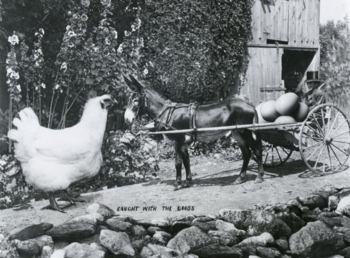
A tall-tale postcard based on a photomontage, illustrating the kind of exaggeration typical for tall tales: A dwarf drives a cart, drawn by a mule, filled with giant eggs. The dwarf is wearing a suit and a top hat. The mule is being confronted on the road by a giant chicken.
A tall tale is a narrative, song or jest that depicts exaggerated situations, incredible boasts or impossible achievements. In a narrow sense, the term applies to stories told by American frontiersmen, and indeed the term itself originates from the mid-1800s.[1] In a wider sense, however, a tall tale is a specimen of mendacious literature, often a folk narrative, whether or not recorded in writing. Written forms, however, also exist as literary creations in their own right. As such, the genre is considered to be universal and of all ages.[2]
Tall tales are not just fictitious, they are patently impossible. If the tall tale is a first-person narrative, the narrator pretends to believe his own story,[3] while in third-person narratives, the account is likewise presented as true. It is a characteristic of the tall tale that it is told by a liar, not by a fallible narrator. While delimitations are difficult to draw sharply, tall tales should therefore be distinguished from fables (which characteristically present a moral) and from science fiction or science fantasy (which by its very nature presents itself as a fantasy).
The American tradition
Tall tales in the American folk tale tradition often snowball round such well-known figures as Bill Cody and Davy Crockett. But there is also a New England tradition, including the tale of Captain Stormalong, who, caught in a storm, steered his ship through the Panama Isthmus, thus digging the canal. Apart from the oral tradition, there are literary specimens by Washington Irving (History of New York, 1809) and Mark Twain (Life on the Mississippi, 1883).[4]
A discontinuous history: mendacious literature
Non-Western traditions
Because lies are of all ages, mendacious literature, whether oral or written, has had a long tradition and seems to occur all over the world. Certain themes recur internationally. Mendacious stories in other cultures include those in the One thousand and One Nights, while they are also found in the Talmud.[5]
The Western tradition
In Western Europe, the precursor is Lucian of Samosata, who lived in the second century, and whose account of his sea voyage is packed with marvels. Of much later date is the eleventh-century Modus florum, where the lie is explicit: by telling mendacious stories, the protagonist is accepted as suitor to the king’s daughter.[6]
Riddles, lies, and wishes
Mendacious songs from the Middle Ages have been handed down in song books. They occupy a position in between other fantastic genres, such as riddles and wish-fulfilment songs. Riddles may depict the impossible or the seemingly impossible. Thus, a bird without wings is a recurring motif, but in certain contexts, it is revealed to stand for something else: it may then be a metaphor for a snowflake. By contrast, an actual impossibility is postulated in a sixteenth-century German song, where a young man undertakes to marry a fair maid if she proves capable of weaving silk from straw.[7]
The lie may be presented as a dream: in one of these songs, the narrator rides a three-legged ox around the world, but while he acknowledges that this is something he has dreamt, let the reader take note: the narrator will not tell lies!
While the narrator pretends to believe his lie, it is not always easy to ascertain what the listener’s response was supposed to be. Was he to take seriously the tale about a mute man giving information, a naked person putting a millstone in his pocket? And was he really intended to believe the stories about Cockaigne, with its cakes hanging from trees, its animals defecating gold, its rejuvenating river? Such stories have been taken to make no claim to anything but entertainment, or alternatively, to satirize man’s greed. On the other hand, it has been assumed that these texts functioned in a context where nothing was deemed impossible: any wish, if cherished in earnest, was capable of fulfilment.[8] Riddle, lie and wish are closely related here.
German
An early German example, Sō ist diz von Lügenen, dates from the fourteenth century, and once again, the lie is explicit: the title announces that this is a book about lies. Later stories deal with Schlaraffenland (a counterpart to Cockaigne), while a compilation of popular lore was published as Der edle Finkenritter (1559). H.W. Kirchhof’s Wendunmut (1563) relates fantastic adventures. Raspe’s Munchausen (1785) was long thought to be German, but its author had in fact fled to England and wrote his famous narrative in English.[9]
French
The French name for such false stories was contes-menteries, and a number of these were collected in Nouvelle fabrique des excellents traits de vérité (1579). Here, too, the title claims that the stories are true. A Swiss literary narrative by Rodolphe Töpffer is the Histoire de M. Cryptogame (1846).[10]
Themes and motifs
Unlike the deliberate lies recounted in more or less literary forms by Poggio, Raspe, Töpffer, Mark Twain and others, popular tradition is subject to decay, which makes it impossible to ascertain the provenance of many mendacious tales. There is, in addition, little doubt that early editions have been lost.[11] The origins and continuity of tales which have been handed down in extant collections are often impossible to trace. But certain motifs and themes recur.
- Cockaigne
The theme of the land bountiful is international. It may be called "Kurrelmurre" in German; "Luilekkerland" (“the land of easy and delight”) in Dutch; "Cuccagna", "Coquaingne" or Cockaygne" in Sicilian, French and English[12], but the theme remains the same. The story of this Paradise on earth, fulfilling all man’s wishes and thus depicting his greed, is utopia and satire at the same time.[13] Varieties occur; thus, the delicacies hanging from trees vary with the tastes of the audience, but delicacies they are, and in all cases they are freely available. There are Italian, French and English versions, and the story seems to have its roots in Antiquity.[14]
- The world inverted
Medieval carnival celebrations were characterized by an inversion of values. A commoner became a prince for a very short time, local authority lay low. The same motif of inversion is found in mendacious stories: a boor outwits Solomon[15], the quarry chases the hunter.
- Nobody
In Dutch and French stories, there occurs a non-existent hero or saint called “St Nobody” or “Seigneur Nemo” (“nemo” being Latin for “nobody”).
- The paradoxical handicap
The blind man seeing, the crippled person swimming or running, the nude man pocketing a stone, are all paradoxes which may be related to the tradition of riddles.[16]
- The tailless beast
A recurring motif is the tailless beast; a traveler rides a donkey suffering from this defect.[17]
References
- ↑ SOED s.v. “tall II".
- ↑ P.J. Meertens, “Leugenliteratuur”, in: A.G.H. Bachrach et al., Moderne Encyclopedie van de Wereldliteratuur , vol. 5. Haarlem/Antwerpen 1982:328-29
- ↑ Meertens 1982:328-29
- ↑ Merriam Webster’s Encyclopedia of Literature, Springfield 1995 s.v. “tall tale”
- ↑ Meertens 1982:328-29
- ↑ Meertens 1982:328-29
- ↑ G. Kalff, ‘’Het lied in de middeleeuwen’’, Ch. IV, “Raadsel-, Leugen en Wenschliederen”. Arnhem 1972[1884]:486-93, (online version [1] accessed Mar. 9, 2010)
- ↑ Kalff 1972[1884]:491, 493
- ↑ Meertens 1982:328-29
- ↑ Meertens 1982:328-29
- ↑ F.P. Wilson, “The English Jest-Books of the Sixteenth and Early Seventeenth Centuries”, in: Shakespearian and Other Studies, Oxford 1970[1969]:285-324
- ↑ Kalff 1972[1884]:489;
Meertens 1982:328-29;
P. de Keyser, “De nieuwe reis naar Luilekkerland”, in: P. de Keyser (ed.), Ars Folklorica Belgica. Noord- en Zuid-Nederlandse volkskunst. Antwerpen/Amsterdam, 1956:7-41 - ↑ De Keyser 1956:14
- ↑ Meertens 1982:328-29
- ↑ Wilson 1982:328-29
- ↑ Kalff 1972[1884]:488
- ↑ Meertens 1982:328-29
Previous Winners
 Aeneid [r]: An epic poem written by Virgil, which depicts the hero Aeneas fleeing from Troy (ancient city), journeying to Carthage, Sicily, and finally to Italy where after battling, he becomes the precursor of the city of Rome; a monumental work of major significance in Western literature. [e]
Aeneid [r]: An epic poem written by Virgil, which depicts the hero Aeneas fleeing from Troy (ancient city), journeying to Carthage, Sicily, and finally to Italy where after battling, he becomes the precursor of the city of Rome; a monumental work of major significance in Western literature. [e] Plane (geometry) [r]: In elementary geometry, a flat surface that entirely contains all straight lines passing through two of its points. [e]
Plane (geometry) [r]: In elementary geometry, a flat surface that entirely contains all straight lines passing through two of its points. [e] Steam [r]: The vapor (or gaseous) phase of water (H2O). [e]
Steam [r]: The vapor (or gaseous) phase of water (H2O). [e] Wasan [r]: Classical Japanese mathematics that flourished during the Edo Period from the 17th to mid-19th centuries. [e]
Wasan [r]: Classical Japanese mathematics that flourished during the Edo Period from the 17th to mid-19th centuries. [e] Racism in Australia [r]: The history of racism and restrictive immigration policies in the Commonwealth of Australia. [e]
Racism in Australia [r]: The history of racism and restrictive immigration policies in the Commonwealth of Australia. [e]- Think tank [r]: Add brief definition or description
 Les Paul [r]: (9 June 1915 – 13 August 2009) American innovator, inventor, musician and songwriter, who was notably a pioneer in the development of the solid-body electric guitar. [e]
Les Paul [r]: (9 June 1915 – 13 August 2009) American innovator, inventor, musician and songwriter, who was notably a pioneer in the development of the solid-body electric guitar. [e] Zionism [r]: The ideology that Jews should form a Jewish state in what is traced as the Biblical area of Palestine; there are many interpretations, including the boundaries of such a state and its criteria for citizenship [e] (September 3)
Zionism [r]: The ideology that Jews should form a Jewish state in what is traced as the Biblical area of Palestine; there are many interpretations, including the boundaries of such a state and its criteria for citizenship [e] (September 3) Earth's atmosphere [r]: An envelope of gas that surrounds the Earth and extends from the Earth's surface out thousands of kilometres, becoming increasingly thinner (less dense) with distance but always held in place by Earth's gravitational pull. [e] (August 27)
Earth's atmosphere [r]: An envelope of gas that surrounds the Earth and extends from the Earth's surface out thousands of kilometres, becoming increasingly thinner (less dense) with distance but always held in place by Earth's gravitational pull. [e] (August 27) Joshua Lawrence Chamberlain [r]: U.S. educator deeply bonded to Bowdoin College, from undergraduate to President; American Civil War general and recipient of the Medal of Honor; Governor of Maine [e] (August 20)
Joshua Lawrence Chamberlain [r]: U.S. educator deeply bonded to Bowdoin College, from undergraduate to President; American Civil War general and recipient of the Medal of Honor; Governor of Maine [e] (August 20) The Sporting Life (album) [r]: A 1994 studio album recorded by Diamanda Galás and John Paul Jones. [e] (August 13}
The Sporting Life (album) [r]: A 1994 studio album recorded by Diamanda Galás and John Paul Jones. [e] (August 13} The Rolling Stones [r]: Famous and influential English blues rock group formed in 1962, known for their albums Let It Bleed and Sticky Fingers, and songs '(I Can't Get No) Satisfaction' and 'Start Me Up'. [e] (August 5)
The Rolling Stones [r]: Famous and influential English blues rock group formed in 1962, known for their albums Let It Bleed and Sticky Fingers, and songs '(I Can't Get No) Satisfaction' and 'Start Me Up'. [e] (August 5) Euler angles [r]: three rotation angles that describe any rotation of a 3-dimensional object. [e] (July 30)
Euler angles [r]: three rotation angles that describe any rotation of a 3-dimensional object. [e] (July 30) Chester Nimitz [r]: United States Navy admiral (1885-1966) who was Commander in Chief, Pacific and Pacific Ocean Areas in World War II [e] (July 23)
Chester Nimitz [r]: United States Navy admiral (1885-1966) who was Commander in Chief, Pacific and Pacific Ocean Areas in World War II [e] (July 23) Heat [r]: A form of energy that flows spontaneously from hotter to colder bodies that are in thermal contact. [e] (July 16)
Heat [r]: A form of energy that flows spontaneously from hotter to colder bodies that are in thermal contact. [e] (July 16) Continuum hypothesis [r]: A statement about the size of the continuum, i.e., the number of elements in the set of real numbers. [e] (July 9)
Continuum hypothesis [r]: A statement about the size of the continuum, i.e., the number of elements in the set of real numbers. [e] (July 9) Hawaiian alphabet [r]: The form of writing used in the Hawaiian Language [e] (July 2)
Hawaiian alphabet [r]: The form of writing used in the Hawaiian Language [e] (July 2) Now and Zen [r]: A 1988 studio album recorded by Robert Plant, with guest contributions from Jimmy Page. [e] (June 25)
Now and Zen [r]: A 1988 studio album recorded by Robert Plant, with guest contributions from Jimmy Page. [e] (June 25) Wrench (tool) [r]: A fastening tool used to tighten or loosen threaded fasteners, with one end that makes firm contact with flat surfaces of the fastener, and the other end providing a means of applying force [e] (June 18)
Wrench (tool) [r]: A fastening tool used to tighten or loosen threaded fasteners, with one end that makes firm contact with flat surfaces of the fastener, and the other end providing a means of applying force [e] (June 18) Air preheater [r]: A general term to describe any device designed to preheat the combustion air used in a fuel-burning furnace for the purpose of increasing the thermal efficiency of the furnace. [e] (June 11)
Air preheater [r]: A general term to describe any device designed to preheat the combustion air used in a fuel-burning furnace for the purpose of increasing the thermal efficiency of the furnace. [e] (June 11) 2009 H1N1 influenza virus [r]: A contagious influenza A virus discovered in April 2009, commonly known as swine flu. [e] (June 4)
2009 H1N1 influenza virus [r]: A contagious influenza A virus discovered in April 2009, commonly known as swine flu. [e] (June 4) Gasoline [r]: A fuel for spark-ignited internal combustion engines derived from petroleum crude oil. [e] (21 May)
Gasoline [r]: A fuel for spark-ignited internal combustion engines derived from petroleum crude oil. [e] (21 May) John Brock [r]: Fictional British secret agent who starred in three 1960s thrillers by Desmond Skirrow. [e] (8 May)
John Brock [r]: Fictional British secret agent who starred in three 1960s thrillers by Desmond Skirrow. [e] (8 May) McGuffey Readers [r]: A set of highly influential school textbooks used in the 19th and early 20th centuries in the elementary grades in the United States. [e] (14 Apr)
McGuffey Readers [r]: A set of highly influential school textbooks used in the 19th and early 20th centuries in the elementary grades in the United States. [e] (14 Apr) Vector rotation [r]: Process of rotating one unit vector into a second unit vector. [e] (7 Apr)
Vector rotation [r]: Process of rotating one unit vector into a second unit vector. [e] (7 Apr) Leptin [r]: Add brief definition or description (31 Mar)
Leptin [r]: Add brief definition or description (31 Mar) Kansas v. Crane [r]: Add brief definition or description (24 Mar)
Kansas v. Crane [r]: Add brief definition or description (24 Mar) Punch card [r]: Add brief definition or description (17 Mar)
Punch card [r]: Add brief definition or description (17 Mar) Jass–Belote card games [r]: Add brief definition or description (10 Mar)
Jass–Belote card games [r]: Add brief definition or description (10 Mar) Leptotes (orchid) [r]: Add brief definition or description (3 Mar)
Leptotes (orchid) [r]: Add brief definition or description (3 Mar) Worm (computers) [r]: Add brief definition or description (24 Feb)
Worm (computers) [r]: Add brief definition or description (24 Feb) Joseph Black [r]: Add brief definition or description (11 Feb 2009)
Joseph Black [r]: Add brief definition or description (11 Feb 2009) Sympathetic magic [r]: Add brief definition or description (17 Jan 2009)
Sympathetic magic [r]: Add brief definition or description (17 Jan 2009) Dien Bien Phu [r]: Add brief definition or description (25 Dec)
Dien Bien Phu [r]: Add brief definition or description (25 Dec)- Blade Runner [r]: Add brief definition or description (25 Nov)
 Piquet [r]: Add brief definition or description (18 Nov)
Piquet [r]: Add brief definition or description (18 Nov) Crash of 2008 [r]: Add brief definition or description (23 Oct)
Crash of 2008 [r]: Add brief definition or description (23 Oct)- Information Management [r]: Add brief definition or description (31 Aug)
 Battle of Gettysburg [r]: Add brief definition or description (8 July)
Battle of Gettysburg [r]: Add brief definition or description (8 July) Drugs banned from the Olympics [r]: Add brief definition or description (1 July)
Drugs banned from the Olympics [r]: Add brief definition or description (1 July) Sea glass [r]: Add brief definition or description (24 June)
Sea glass [r]: Add brief definition or description (24 June) Dazed and Confused (Led Zeppelin song) [r]: Add brief definition or description (17 June)
Dazed and Confused (Led Zeppelin song) [r]: Add brief definition or description (17 June) Hirohito [r]: Add brief definition or description (10 June)
Hirohito [r]: Add brief definition or description (10 June) Henry Kissinger [r]: Add brief definition or description (3 June)
Henry Kissinger [r]: Add brief definition or description (3 June)- Palatalization [r]: Add brief definition or description (27 May)
 Intelligence on the Korean War [r]: Add brief definition or description (20 May)
Intelligence on the Korean War [r]: Add brief definition or description (20 May) Trinity United Church of Christ, Chicago [r]: Add brief definition or description (13 May)
Trinity United Church of Christ, Chicago [r]: Add brief definition or description (13 May) BIOS [r]: Add brief definition or description (6 May)
BIOS [r]: Add brief definition or description (6 May) Miniature Fox Terrier [r]: Add brief definition or description (23 April)
Miniature Fox Terrier [r]: Add brief definition or description (23 April) Joseph II [r]: Add brief definition or description (15 Apr)
Joseph II [r]: Add brief definition or description (15 Apr) British and American English [r]: Add brief definition or description (7 Apr)
British and American English [r]: Add brief definition or description (7 Apr) Count Rumford [r]: Add brief definition or description (1 April)
Count Rumford [r]: Add brief definition or description (1 April) Whale meat [r]: Add brief definition or description (25 March)
Whale meat [r]: Add brief definition or description (25 March) Naval guns [r]: Add brief definition or description (18 March)
Naval guns [r]: Add brief definition or description (18 March) Sri Lanka [r]: Add brief definition or description (11 March)
Sri Lanka [r]: Add brief definition or description (11 March) Led Zeppelin [r]: Add brief definition or description (4 March)
Led Zeppelin [r]: Add brief definition or description (4 March) Martin Luther [r]: Add brief definition or description (20 February)
Martin Luther [r]: Add brief definition or description (20 February) Cosmology [r]: Add brief definition or description (4 February)
Cosmology [r]: Add brief definition or description (4 February) Ernest Rutherford [r]: Add brief definition or description(28 January)
Ernest Rutherford [r]: Add brief definition or description(28 January) Edinburgh [r]: Add brief definition or description (21 January)
Edinburgh [r]: Add brief definition or description (21 January) Russian Revolution of 1905 [r]: Add brief definition or description (8 January 2008)
Russian Revolution of 1905 [r]: Add brief definition or description (8 January 2008) Phosphorus [r]: Add brief definition or description (31 December)
Phosphorus [r]: Add brief definition or description (31 December) John Tyler [r]: Add brief definition or description (6 December)
John Tyler [r]: Add brief definition or description (6 December) Banana [r]: Add brief definition or description (22 November)
Banana [r]: Add brief definition or description (22 November) Augustin-Louis Cauchy [r]: Add brief definition or description (15 November)
Augustin-Louis Cauchy [r]: Add brief definition or description (15 November)- B-17 Flying Fortress (bomber) [r]: Add brief definition or description - 8 November 2007
 Red Sea Urchin [r]: Add brief definition or description - 1 November 2007
Red Sea Urchin [r]: Add brief definition or description - 1 November 2007 Symphony [r]: Add brief definition or description - 25 October 2007
Symphony [r]: Add brief definition or description - 25 October 2007 Oxygen [r]: Add brief definition or description - 18 October 2007
Oxygen [r]: Add brief definition or description - 18 October 2007 Origins and architecture of the Taj Mahal [r]: Add brief definition or description - 11 October 2007
Origins and architecture of the Taj Mahal [r]: Add brief definition or description - 11 October 2007 Fossilization (palaeontology) [r]: Add brief definition or description - 4 October 2007
Fossilization (palaeontology) [r]: Add brief definition or description - 4 October 2007 Cradle of Humankind [r]: Add brief definition or description - 27 September 2007
Cradle of Humankind [r]: Add brief definition or description - 27 September 2007 John Adams [r]: Add brief definition or description - 20 September 2007
John Adams [r]: Add brief definition or description - 20 September 2007 Quakers [r]: Add brief definition or description - 13 September 2007
Quakers [r]: Add brief definition or description - 13 September 2007 Scarborough Castle [r]: Add brief definition or description - 6 September 2007
Scarborough Castle [r]: Add brief definition or description - 6 September 2007 Jane Addams [r]: Add brief definition or description - 30 August 2007
Jane Addams [r]: Add brief definition or description - 30 August 2007 Epidemiology [r]: Add brief definition or description - 23 August 2007
Epidemiology [r]: Add brief definition or description - 23 August 2007 Gay community [r]: Add brief definition or description - 16 August 2007
Gay community [r]: Add brief definition or description - 16 August 2007 Edward I [r]: Add brief definition or description - 9 August 2007
Edward I [r]: Add brief definition or description - 9 August 2007
Rules and Procedure
Rules
- The primary criterion of eligibility for a new draft is that it must have been ranked as a status 1 or 2 (developed or developing), as documented in the History of the article's Metadate template, no more than one month before the date of the next selection (currently every Thursday).
- Any Citizen may nominate a draft.
- No Citizen may have nominated more than one article listed under "current nominees" at a time.
- The article's nominator is indicated simply by the first name in the list of votes (see below).
- At least for now--while the project is still small--you may nominate and vote for drafts of which you are a main author.
- An article can be the New Draft of the Week only once. Nominated articles that have won this honor should be removed from the list and added to the list of previous winners.
- Comments on nominations should be made on the article's talk page.
- Any draft will be deleted when it is past its "last date eligible". Don't worry if this happens to your article; consider nominating it as the Article of the Week.
- If an editor believes that a nominee in his or her area of expertise is ineligible (perhaps due to obvious and embarrassing problems) he or she may remove the draft from consideration. The editor must indicate the reasons why he has done so on the nominated article's talk page.
Nomination
See above section "Add New Nominees Here".
Voting
- To vote, add your name and date in the Supporters column next to an article title, after other supporters for that article, by signing
<br />~~~~. (The date is necessary so that we can determine when the last vote was added.) Your vote is alloted a score of 1. - Add your name in the Specialist supporters column only if you are an editor who is an expert about the topic in question. Your vote is alloted a score of 1 for articles that you created and 2 for articles that you did not create.
- You may vote for as many articles as you wish, and each vote counts separately, but you can only nominate one at a time; see above. You could, theoretically, vote for every nominated article on the page, but this would be pointless.
Ranking
- The list of articles is sorted by number of votes first, then alphabetically.
- Admins should make sure that the votes are correctly tallied, but anyone may do this. Note that "Specialist Votes" are worth 3 points.
Updating
- Each Thursday, one of the admins listed below should move the winning article to the Current Winner section of this page, announce the winner on Citizendium-L and update the "previous winning drafts" section accordingly.
- The winning article will be the article at the top of the list (ie the one with the most votes).
- In the event of two or more having the same number of votes :
- The article with the most specialist supporters is used. Should this fail to produce a winner, the article appearing first by English alphabetical order is used.
- The remaining winning articles are guaranteed this position in the following weeks, again in alphabetical order. No further voting should take place on these, which remain at the top of the table with notices to that effect. Further nominations and voting take place to determine future winning articles for the following weeks.
- Winning articles may be named New Draft of the Week beyond their last eligible date if their circumstances are so described above.
- The article with the most specialist supporters is used. Should this fail to produce a winner, the article appearing first by English alphabetical order is used.
Administrators
The Administrators of this program are the same as the admins for CZ:Article of the Week.
References
See Also
- CZ:Article of the Week
- CZ:Markup tags for partial transclusion of selected text in an article
- CZ:Monthly Write-a-Thon
| Citizendium Initiatives | ||
|---|---|---|
| Eduzendium | Featured Article | Recruitment | Subpages | Core Articles | Uncategorized pages | Requested Articles | Feedback Requests | Wanted Articles |
|width=10% align=center style="background:#F5F5F5"| |}



